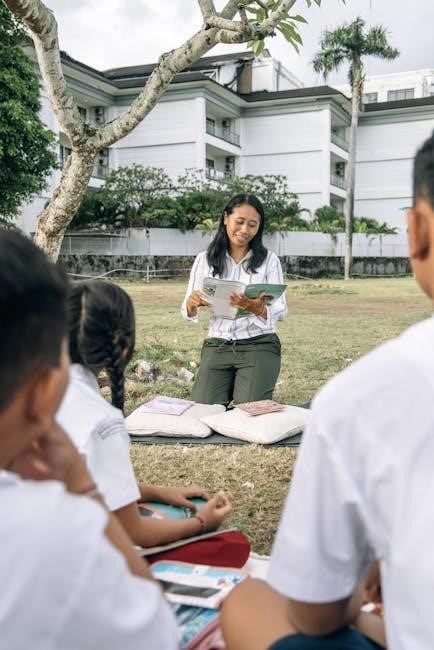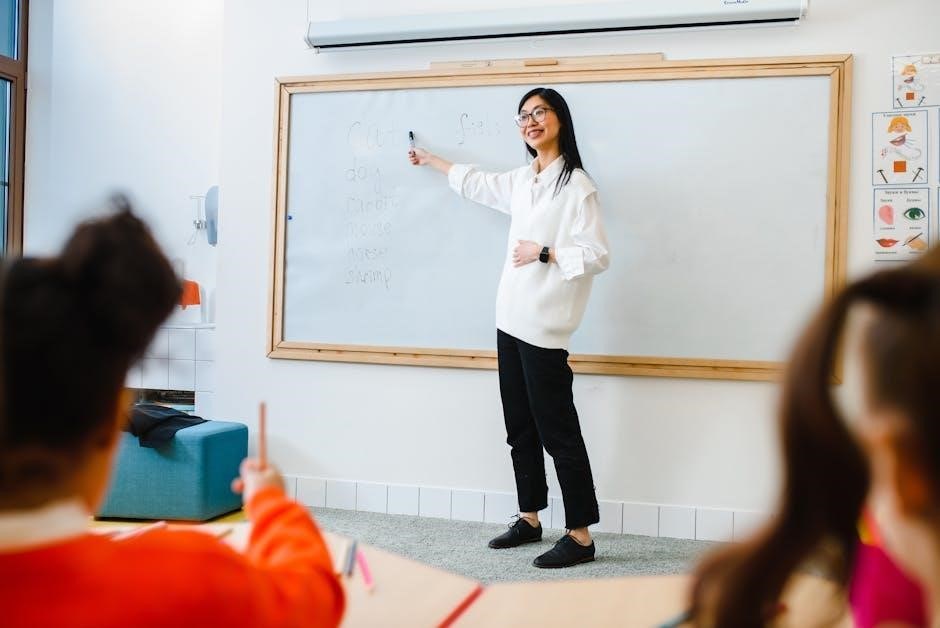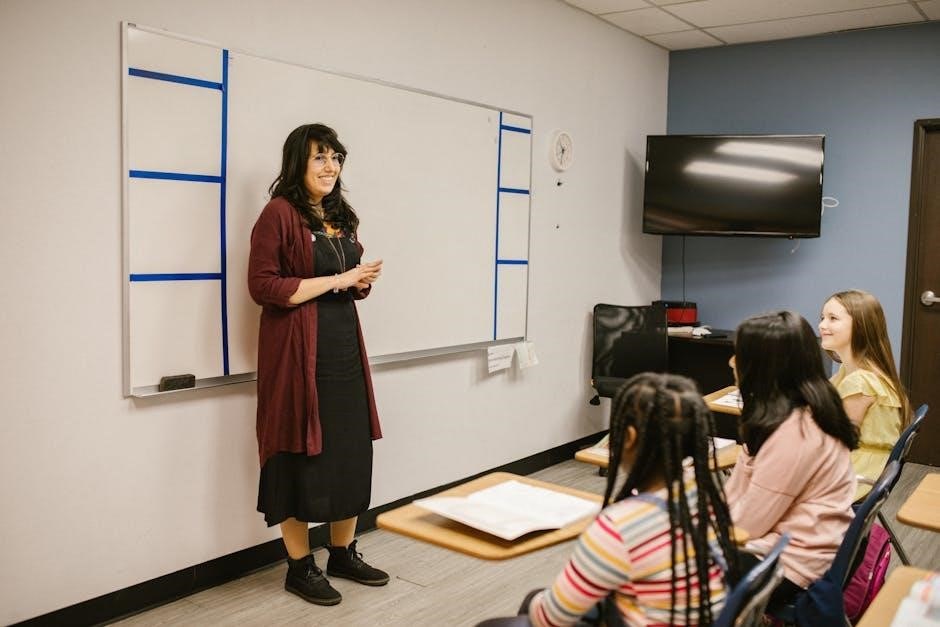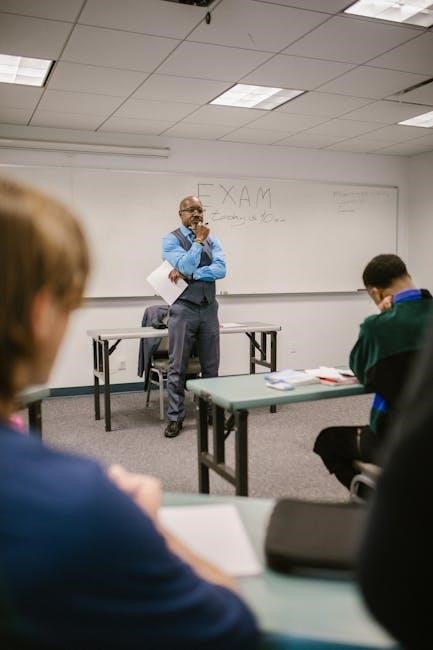Differentiated Instruction (DI) tailors teaching to meet the diverse needs of English Language Learners (ELLs)‚ ensuring equitable access to content while honoring their unique linguistic and cultural backgrounds․
Understanding the Importance of Differentiation for ELLs
Differentiated instruction is vital for English Language Learners (ELLs) due to their diverse language proficiency levels‚ cultural backgrounds‚ and learning experiences․ Traditional‚ one-size-fits-all approaches often fail to address these unique needs‚ creating barriers to academic success․ By tailoring instruction‚ teachers can bridge language gaps‚ make content more accessible‚ and ensure ELLs develop both linguistic and academic skills․ Differentiation fosters an inclusive classroom environment‚ allowing ELLs to thrive alongside their peers and achieve measurable academic outcomes․
Key Principles of Differentiated Instruction
Differentiated instruction is rooted in three core principles: flexibility‚ student-centered learning‚ and intentional planning․ Teachers recognize that each student learns uniquely and adapt content‚ process‚ and products accordingly․ Pre-assessments identify learners’ strengths and needs‚ guiding instruction․ Flexible grouping allows for varied learning experiences‚ while formative assessments monitor progress․ Culturally responsive practices and scaffolding ensure ELLs access rigorous content․ These principles ensure instruction is inclusive‚ equitable‚ and tailored to diverse linguistic and academic profiles․

Assessing ELL Students’ Needs
Assessing ELL students involves identifying their language proficiency‚ academic strengths‚ and cultural backgrounds through pre-assessments and formative evaluations to tailor instruction effectively․
Pre-Assessment Strategies for ELLs
Effective pre-assessment strategies for ELLs include language proficiency tests‚ diagnostic reading assessments‚ and student surveys to identify their academic strengths‚ language levels‚ and cultural backgrounds․ These tools help educators understand where students are in their language acquisition journey and tailor instruction accordingly․ Additionally‚ reviewing prior academic records and conducting informal interviews can provide valuable insights into a student’s learning history and preferences‚ further guiding the differentiation process․
Using Formative Assessments to Guide Instruction
Formative assessments are crucial for guiding instruction and ensuring ELLs meet learning goals․ Strategies like exit tickets‚ checkpoints‚ and verbal feedback help teachers monitor progress and adjust instruction․ These assessments identify gaps in understanding‚ allowing for timely interventions․ For ELLs‚ formative assessments also provide opportunities to practice language skills and receive constructive feedback․ By regularly gauging student progress‚ educators can differentiate instruction‚ scaffold learning‚ and build on students’ strengths‚ fostering a more inclusive and effective learning environment tailored to their needs․

Differentiating Instructional Content
Differentiating instructional content for ELLs involves adapting materials to their language levels using visual aids‚ simplified texts‚ and bilingual resources to enhance comprehension and engagement․
Using Visual Aids to Support ELLs
Visual aids like charts‚ graphs‚ and images are powerful tools for ELLs‚ bridging language gaps and enhancing comprehension․ They make complex concepts more accessible‚ allowing students to connect visuals with new vocabulary and ideas․ Incorporating videos and interactive media also engages learners and provides context‚ making lessons more dynamic․ By pairing visuals with verbal instructions‚ teachers can ensure ELLs grasp content effectively‚ fostering a more inclusive and supportive learning environment․
Adapting Text Complexity for ELLs
Adapting text complexity involves simplifying vocabulary and sentence structures while preserving core content․ This ensures ELLs can engage with material without becoming overwhelmed․ Teachers can use graphic organizers or summaries to break down texts‚ making them more manageable․ Additionally‚ providing bilingual resources or translated versions helps bridge language barriers‚ allowing ELLs to focus on understanding the subject matter․ This approach supports language acquisition while maintaining academic rigor‚ ensuring all students can participate meaningfully in classroom activities and achieve their learning goals․
Providing Bilingual Resources
Providing bilingual resources is a cornerstone of differentiated instruction for ELLs‚ offering dual-language materials that bridge language gaps․ These resources‚ such as translated textbooks or online tools‚ support comprehension and reduce cognitive load․ By allowing students to access information in their native language‚ teachers facilitate deeper understanding and engagement․ Bilingual resources also foster a sense of inclusivity‚ validating students’ linguistic backgrounds and promoting cultural relevance․ This strategy ensures ELLs can access grade-level content while continuing to develop their English proficiency‚ making learning more accessible and effective․

Differentiating the Process of Learning
Differentiating the process involves tailoring how students engage with content‚ using flexible grouping‚ hands-on activities‚ and offering choices to meet diverse learning needs and preferences effectively․
Flexible Grouping Strategies for ELLs
Flexible grouping strategies allow ELLs to work in small‚ mixed-ability groups based on specific skills or tasks․ This approach encourages peer collaboration‚ language practice‚ and differentiated support; Teachers can group students by language proficiency‚ learning goals‚ or interests‚ ensuring each group receives targeted instruction․ Temporary groups can be formed for particular activities‚ while more stable groups provide ongoing support․ This method fosters inclusivity‚ promotes cultural exchange‚ and helps ELLs build confidence in their language skills through shared learning experiences․ Regular rotation of groups ensures varied interactions and keeps students engaged․ By adapting group dynamics‚ teachers can meet the diverse needs of ELLs effectively‚ enhancing both language acquisition and academic performance․
Incorporating Movement and Hands-On Activities
Incorporating movement and hands-on activities engages ELLs kinesthetically‚ linking physical actions to language learning․ These activities‚ such as role-playing or manipulatives‚ make abstract concepts tangible and enhance comprehension․ Movement fosters active participation‚ allowing ELLs to connect new vocabulary with gestures or real-world applications․ Hands-on tasks‚ like science experiments or art projects‚ encourage collaboration and reduce language barriers․ By integrating movement and practical exercises‚ teachers create a dynamic‚ inclusive learning environment that caters to diverse learning styles and accelerates language acquisition for ELLs while making lessons more memorable and culturally relevant․
Offering Choices in Learning
Offering choices in learning empowers ELL students by allowing them to take ownership of their education․ This strategy respects their individual interests‚ language levels‚ and learning styles․ Choices can be incorporated through differentiated assignments‚ topic selections‚ or learning modalities‚ such as writing‚ presenting‚ or creating visual projects․ Providing options fosters engagement‚ motivation‚ and a sense of autonomy‚ which are crucial for language development․ By giving ELLs the freedom to make decisions‚ teachers create a personalized and inclusive learning environment that supports their unique needs and encourages academic growth while building confidence in their abilities․

Differentiating Learning Products
Differentiating learning products allows ELLs to demonstrate understanding through varied assignments‚ such as tiered tasks‚ multimedia presentations‚ or portfolios‚ catering to their strengths and language levels․
Tiered Assignments for ELLs
Tiered assignments provide scaffolded learning opportunities tailored to ELLs’ varying language proficiency levels․ Teachers design tasks with increasing complexity‚ incorporating visual aids and language support‚ ensuring accessibility while challenging students appropriately․ This approach allows ELLs to engage with content in meaningful ways‚ building both language skills and subject matter knowledge․ By offering differentiated outcomes‚ educators ensure that all learners can achieve success‚ fostering confidence and academic growth in a supportive environment․
Project-Based Learning for ELLs
Project-based learning (PBL) engages ELLs in authentic‚ meaningful tasks that integrate language development with content learning․ By working on real-world projects‚ students apply skills in collaborative settings‚ fostering creativity and critical thinking․ Teachers provide scaffolding through visual aids‚ bilingual resources‚ and structured timelines‚ allowing ELLs to express their understanding in diverse ways․ PBL encourages active participation‚ cultural expression‚ and peer support‚ making it an effective strategy to differentiate instruction and promote academic success for linguistically diverse learners․
Using Portfolios and Self-Assessment
Portfolios and self-assessment empower ELLs to track their progress and reflect on their learning․ By maintaining collections of their work‚ such as writings‚ projects‚ and reflections‚ students can visually see their growth over time․ Teachers can use these portfolios to identify strengths and areas for improvement‚ tailoring instruction to individual needs․ Self-assessment tools‚ like checklists or reflection journals‚ encourage ELLs to take ownership of their learning‚ fostering self-awareness and confidence․ This approach promotes personalized growth and celebrates diverse achievements․
Creating an Inclusive Learning Environment
Creating an inclusive learning environment involves respecting diverse backgrounds‚ using visual aids‚ and promoting collaboration to ensure all ELL students feel supported and engaged in their education․
Building a Supportive Classroom Culture
Building a supportive classroom culture for ELL students involves fostering respect‚ empathy‚ and inclusivity․ Teachers can create a safe environment by modeling positive communication‚ encouraging peer collaboration‚ and celebrating diverse backgrounds․ Incorporating students’ cultural experiences into lessons helps build connections and confidence․ Establishing clear expectations and predictable routines also reduces anxiety for ELLs․ By promoting a growth mindset and providing opportunities for students to share their perspectives‚ educators can create a space where all learners feel valued and empowered to succeed academically and socially․
Encouraging Peer Collaboration
Encouraging peer collaboration for ELL students fosters language development‚ cultural exchange‚ and academic confidence․ Teachers can facilitate small-group activities where ELLs work alongside native speakers‚ promoting mutual support and dialogue․ Pairing students with shared interests or language levels ensures meaningful interactions; Providing sentence frames or visual aids helps ELLs communicate effectively․ Collaborative tasks‚ such as problem-solving or project-based learning‚ enable students to contribute diverse perspectives․ By fostering teamwork and inclusivity‚ educators create a dynamic learning environment where all students thrive and grow together․
Promoting Cultural Awareness
Promoting cultural awareness in the classroom is essential for ELL students‚ as it fosters inclusivity and respect for diverse backgrounds․ Teachers can incorporate multicultural materials and activities that reflect students’ heritage‚ making learning relevant and engaging․ By scaffolding language instruction while encouraging the use of students’ home language‚ educators support their cultural identity․ Creating an environment that values diversity ensures ELLs feel valued and connected to their learning community‚ enhancing their academic and social growth․

Assessment Strategies for ELLs
Effective assessment strategies for ELLs include using formative assessments‚ providing timely feedback‚ and incorporating visual aids to scaffold language development and ensure comprehension․
Using Formative Assessments
Formative assessments are crucial for monitoring ELLs’ progress and understanding their needs․ Teachers can use strategies like exit tickets‚ group discussions‚ and visual projects to gauge comprehension․ These assessments help identify language barriers and content challenges‚ allowing for immediate adjustments․ Providing timely‚ constructive feedback enables ELLs to refine their skills․ Additionally‚ incorporating students’ first language for explanations can enhance understanding․ Regular formative assessments ensure instruction remains tailored to their evolving needs‚ fostering a supportive and inclusive learning environment․ This approach promotes active learning and cultural responsiveness․
Designing Summative Assessments
Summative assessments for ELLs should be comprehensive yet fair‚ measuring both content mastery and language proficiency․ Teachers can provide bilingual resources or visual aids to ensure clarity․ Offering alternative formats‚ such as oral presentations or multimedia projects‚ accommodates diverse learning styles․ Clear rubrics and scaffolded tasks help ELLs demonstrate their understanding․ Timely‚ constructive feedback is essential‚ highlighting strengths and areas for growth․ These assessments not only evaluate learning but also inform future instruction‚ ensuring ELLs receive targeted support․ They play a key role in fostering academic success and confidence․
Providing Timely and Constructive Feedback
Timely and constructive feedback is crucial for ELLs‚ helping them understand their progress and areas for improvement․ Teachers should use specific‚ clear language to highlight strengths and offer actionable suggestions․ For example‚ instead of saying “good job‚” a teacher might say‚ “Your use of vocabulary is excellent‚ but try to vary your sentence structures․” Providing feedback in multiple forms—verbal‚ written‚ or visual—ensures ELLs can grasp it in ways that suit their learning preferences․ Regular check-ins and scaffolded feedback also build confidence and promote continuous growth in both language and content skills․

Culturally Responsive Teaching Practices
Culturally responsive teaching connects ELLs’ cultural backgrounds to lessons‚ fostering engagement and inclusivity․ It respects diverse perspectives‚ encourages cultural sharing‚ and integrates multicultural materials to enrich learning experiences․
Incorporating Multicultural Materials
Incorporating multicultural materials enriches ELL instruction by reflecting diverse cultures‚ languages‚ and experiences․ Teachers can select texts‚ images‚ and resources that mirror students’ backgrounds‚ fostering connection and engagement․ Visual aids‚ such as posters and digital media‚ can highlight global perspectives․ Additionally‚ bilingual books and translated resources support language development while preserving cultural identity․ Encouraging students to share their traditions and stories integrates their voices into lessons‚ creating an inclusive environment․ These practices ensure that ELLs feel valued and connected to the curriculum‚ enhancing their academic and cultural growth․
Scaffolding Language Instruction
Scaffolding language instruction involves providing temporary support to ELLs as they develop language proficiency․ Teachers can use visual aids‚ simplified language‚ and sentence frames to break down complex tasks․ Gradual release of responsibility ensures students gain independence․ Offering frequent‚ targeted feedback and encouraging peer support fosters a collaborative learning environment․ Scaffolding strategies‚ such as pre-teaching vocabulary and using graphic organizers‚ help bridge language gaps‚ making content more accessible․ This approach aligns with students’ language levels‚ promoting confidence and fluency in their academic interactions․
Encouraging Home-Language Use
Encouraging ELL students to use their home language fosters a sense of identity and supports their academic growth․ Teachers can integrate bilingual resources and promote peer discussions in students’ native languages․ Allowing students to complete assignments or participate in class in their home language builds confidence and enhances understanding․ This approach also strengthens parental involvement‚ as families can support their children’s learning more effectively․ By valuing students’ linguistic backgrounds‚ educators create an inclusive environment that celebrates diversity and accelerates language acquisition․

Technology Integration in DI for ELLs
Technology enhances differentiation by providing ELLs with language learning apps‚ translation tools‚ and multimedia resources‚ making content accessible and engaging while supporting individual learning needs․
Using Language Learning Apps
Language learning apps provide personalized and interactive opportunities for ELLs to practice vocabulary‚ grammar‚ and pronunciation at their own pace․ These tools often include gamified activities‚ audio clips‚ and real-time feedback‚ making learning engaging and effective․ Apps like Duolingo or Babbel cater to different proficiency levels‚ allowing teachers to assign tailored tasks that align with individual student needs․ Additionally‚ many apps offer cultural insights‚ helping ELLs connect language learning to real-world contexts․ By integrating these digital resources‚ educators can create a differentiated and inclusive learning environment that supports linguistic development and cultural understanding․
Implementing Translation Tools
Translation tools enable ELL students to access complex texts and materials in their native language‚ fostering comprehension and reducing language barriers․ By using tools like Google Translate or Microsoft Translator‚ educators can provide immediate support during lessons․ These resources also help students engage with homework and reading assignments more effectively․ Additionally‚ translation tools can facilitate communication between teachers and non-English-speaking parents‚ promoting collaboration and student success․ Integrating these tools creates a more inclusive and differentiated learning environment tailored to ELLs’ needs․
Leveraging Multimedia Resources
Multimedia resources‚ such as videos‚ audio clips‚ and interactive simulations‚ provide ELL students with diverse ways to engage with content․ These tools can simplify complex concepts through visual and auditory support‚ making lessons more accessible․ For example‚ educational videos with subtitles or animations can help ELLs grasp new vocabulary and ideas․ Additionally‚ interactive multimedia allows students to explore topics at their own pace‚ fostering independent learning․ By integrating these resources‚ teachers create a dynamic and inclusive classroom environment that caters to varied learning styles and language proficiency levels․

Parental and Community Involvement
Fostering partnerships with ELL families and communities strengthens academic support․ Workshops‚ volunteering‚ and cultural events create a collaborative environment‚ ensuring consistency between home and school efforts․
Engaging ELL Families
Engaging ELL families requires culturally responsive communication and involvement strategies․ Schools can host bilingual workshops‚ parent-teacher conferences with interpreters‚ and cultural events to build trust․ Providing resources like language learning apps and homework guides in families’ native languages fosters collaboration․ Regular updates on student progress through accessible platforms ensure parents stay informed․ Encouraging volunteers in classrooms or mentorship programs also strengthens ties․ By valuing families’ linguistic and cultural backgrounds‚ educators create a supportive network that enhances learning outcomes for ELL students․
Building Community Partnerships
Building community partnerships is vital for supporting ELL students’ academic and cultural growth․ Schools can collaborate with local organizations‚ libraries‚ and cultural centers to provide resources and enrichment opportunities․ Partnerships with community groups ensure access to bilingual materials‚ workshops‚ and mentorship programs tailored to ELLs’ needs․ These collaborations also foster cultural awareness and mutual respect‚ creating a bridge between schools and diverse communities․ By leveraging community resources‚ educators can enhance ELLs’ learning experiences and promote inclusivity․
Strategies for Parent-Teacher Communication
Effective parent-teacher communication is crucial for supporting ELL students’ success․ Regular meetings‚ bilingual newsletters‚ and translation tools help bridge language gaps․ Teachers can use digital platforms to share progress and involve parents in their child’s learning․ Providing resources and tips for parents to support language development at home fosters collaboration․ Open dialogue and consistent updates ensure parents are actively engaged in their child’s education‚ creating a supportive partnership between home and school for ELLs;

Professional Development for Educators
Professional development equips educators with strategies to differentiate instruction for ELLs‚ enhancing their ability to meet diverse linguistic and cultural needs effectively in the classroom․
Workshops and Training for Differentiation
Workshops and training programs provide educators with practical strategies to differentiate instruction for ELL students․ These sessions focus on understanding ELLs’ unique needs‚ such as cultural backgrounds and varying levels of language proficiency․ Teachers learn to incorporate visual aids‚ flexible grouping‚ and formative assessments to create inclusive learning environments․ Hands-on activities and peer collaboration are often emphasized‚ enabling educators to apply differentiation techniques effectively․ Such professional development opportunities ensure teachers are well-equipped to support ELLs’ academic and linguistic growth‚ fostering a more equitable and engaging classroom experience․
Collaborative Planning and Peer Support
Collaborative planning and peer support are essential for effectively differentiating instruction for ELL students․ Teachers work together to design lessons that cater to diverse language levels and cultural backgrounds․ Peer support fosters a culture of shared responsibility‚ where educators can observe‚ provide feedback‚ and refine differentiation strategies․ This collaborative approach ensures consistency and innovation in addressing ELLs’ unique needs‚ ultimately enhancing their academic engagement and language development․ By leveraging collective expertise‚ teachers create a more inclusive and effective learning environment for all students․ This teamwork is vital for sustained success in differentiation practices․
Peer Observations and Feedback
Peer observations and feedback are powerful tools for improving differentiated instruction for ELL students․ Teachers observe one another’s classrooms to identify effective strategies and areas for growth․ Constructive feedback is shared‚ focusing on enhancing engagement and language acquisition for ELLs․ This process promotes professional growth‚ fosters a supportive school culture‚ and ensures that differentiation practices are aligned with student needs․ Regular peer feedback helps educators refine their techniques‚ leading to more tailored and impactful instruction for diverse learners․ This collaborative approach enhances overall teaching quality and student outcomes․